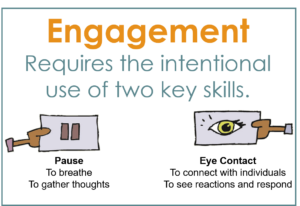
- Greg Owen-Boger Myths Debunked, Presentations, The Orderly Conversation
Some time back, Dale and I were the guest speakers on a webinar. The topic was about how we’ve redefined business presentations as Orderly Conversations. We were talking about the use of eye contact and pausing in order to get yourself engaged in the conversation.
When we talk about being engaged as a presenter, we’re talking about the state of being in the “here and now” so that you are able to think on your feet and lead what feels like a natural two-way conversation. It’s talking with your audience rather than talking at them.

- Eye contact: The intentional use of eye contact allows you to make a connection with people so that you can read their reactions and respond.
- Pause: The intentional use of a good pause now and again allows you to gather your thoughts and take control of what you’re saying.
After we made this point in the webinar, I noticed that someone had used the chat function to comment, “Eye contact and Pausing… is that all you got?!”
It just so happens that the comment came from a competitor who was, I assume, baiting us. My in-the-moment reaction was to address the guy’s snarky comment and make an argument for why we focus so heavily on these very basic skills. But I quickly thought better of it. Delivering a virtual presentation via webinar was not the time to squabble with a competitor.
What the guy didn’t comprehend is that we’re not talking about the appearance of eye contact or the dramatic affect that a pause will have on the audience. (Typical run-of-the-mill presentation trainers often teach that, though.) We’re talking about the very opposite: the calming effect it has on the speaker.
When you’re connected with people and in control of what you’re saying, you’re able to be an effective communicator. You’re fully engaged in the conversation. You’re not thinking about how you are performing; you’re thinking about your content, the audience, and whether they’re following along. These are the same things you think about during everyday low-stakes conversations.
Managing Nervousness
If we can agree that the key skills that help you become engaged in the conversation are eye contact and pausing, we can also see that these ordinary skills, when used intentionally, even in extraordinary situations, can help you manage your nervousness.
We always ask workshop participants what nervousness feels like to them. These are some common answers, and they are all the result of the absence of pausing and/or eye contact:
- In my head
- Can’t see clearly
- Out of body experience
- Not thinking clearly
- Mind is racing
- Mind shuts down
- Noise in my head
- Can’t catch my breath
If you’re a nervous presenter (and even if you’re not), next time you’re feeling uneasy at the front of the room, remember to look at people. Really see them. Connect. And pause every once in a while. Give your brain a chance to catch up. Think. Breathe.
Over time, these skills will become second nature to you, and you won’t have to be so intentional about their use.
So… Eye contact and pausing… is that all we got? Nope. Not at all, but these essential skills are the foundation for all of the communication training we provide at Turpin Communication.

